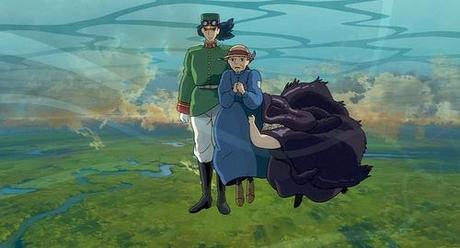
Norm Holland has an interesting post on Howl’s Moving Castle:
It’s a love story, it’s an anti-war film, and I think it’s about integrating one’s personality and relationships while constrained by the power of others, in particular, wartime political power. That’s a mouthful. Just say, this is a movie about psychotherapy—kind of....I thought this comment particularly interesting:
Psychotherapy—perhaps that’s why all the females in this film are mother-figures. Miyazaki was deeply attached to his mother in his childhood, and mothering plays a role in all his films. Then, too, motherhood shapes us like any sorcerer’s spell. Miyazaki’s mother-figures in Howl are all sexual beings. Three are or were attracted to Howl [Sophie, The Witch of the Waste, Suliman]. The other two, Sophie’s real mother and her sister seem just plain cute and sexual.
Jungian analyst Hayao Kawai suggests in his definitive book, The Japanese Psyche, that the Japanese ego, i.e., consciousness, is female (unlike the Western ego, which is male). The Japanese, he feels, see things from a feminine point of view. Until the defeat in World War II, masculinity and patriarchy disguised this underlying femininity, but in folk and fairy tales “female heroes” (like Miyazaki’s) took the active role. So here. Glamorous as Howl is, the real power rests with Sophie and, above all, Suliman. The women are powerful, the men much less so, except for Howl.I wonder if that’s why anime and manga are so attractive to so many young (and not so young) people in the West.
My friend and colleague, the late Tim Perper, and his wife, Martha Cornog, were very interested in manga and anime and, in particular, in the treatment of sexuality and of women. They tell me there is a long folk tradition of stories about strong women who persevere and endure. That’s certainly Sophie, but also, in somewhat different ways, Suliman, with all her power, and the Witch of the Waste.
Holland again:
Howl’s castle symbolizes personal identity. It is multi-faceted as shown by its several pairs of “eyes.” It includes all kinds of things and activities that combine and change and are created or abandoned. The final unmasking of Turnip takes place on the last remaining fragment of the castle. The castle finally becomes a home. (Another saying: a man’s home is his castle.)
I’ve suggested that this film is about becoming who you really are: finding your true identity, a kind of psychotherapy. These characters’ true identities differ from those imposed on them by various sorceries (including motherhood?). And they find their true identities in a characteristically psychoanalytic way, by losing the false selves, disintegrating, and then rebuilding. Sophie, Turnip-Head, Calcifer, and the Witch of the Waste all do this clearly enough, but Howl does it most explicitly. He begins by being vain and cowardly, his heart displaced into Calcifer. But then he regresses to childhood (the scene where he swallows the star), and Sophie brings him back by giving him his heart again, his ability to love. “A heart is a heavy burden,” says Sophie. Howl ends up as Freud might put it, able to love and to work. He is no longer childish, but an adult brave and loving, master in his own house. And that house, Howl’s Moving Castle soars above the warships down below it.

